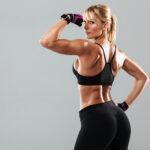Seated Barbell Wrist Curl: Exercise Overview
The seated barbell wrist curl is a specialized exercise designed to strengthen the forearm flexor muscles, which play a critical role in grip strength and wrist stability. This variation of the wrist curl isolates the forearms, making it an excellent addition to arm-focused workouts or strength-training routines. Strong forearms enhance performance in numerous exercises, such as deadlifts and pull-ups, by improving grip capacity, which can allow you to lift heavier weights safely (Szymanski et al., 2004). Due to the forearms’ resilience, they may require higher training frequency or volume to achieve noticeable strength and size gains. The seated barbell wrist curl can be incorporated into arm workouts, upper-body sessions, or full-body programs to support overall functional strength (Schoenfeld, 2010).
How to Perform the Seated Barbell Wrist Curl
- Choose an appropriate weight and load it onto a barbell. Sit on a bench with your feet flat on the floor.
- Rest your forearms comfortably on your thighs, allowing your wrists to extend just beyond the edges of your knees, palms facing up (supinated grip).
- Grip the barbell with both hands, keeping your fingers wrapped securely around it.
- Curl the barbell upward by flexing your wrists, contracting the forearm flexor muscles as you bring the bar toward your body.
- Pause briefly when the forearms are fully contracted, then slowly lower the barbell back to the starting position with control.
- Repeat for the desired number of repetitions.
Tips for Optimal Performance
- Breathe Consistently: Exhale as you curl the barbell upward and inhale as you lower it to support controlled movement and muscle oxygenation.
- Control the Eccentric Phase: Lower the barbell slowly during the descent to increase time under tension, which enhances muscle activation and growth (Schoenfeld, 2016).
- Isolate the Wrists: Move only at the wrists, keeping your fingers closed around the barbell to avoid engaging the hand muscles excessively.
- Maintain Proper Posture: Keep your back straight and core engaged to ensure a stable seated position and prevent strain.
- Avoid Momentum: Perform the movement deliberately, avoiding jerky motions to maximize forearm engagement and reduce injury risk.
- Adjust Grip and Weight: Use a weight that challenges you within your target rep range (e.g., 10–15 reps for hypertrophy) while maintaining proper form. A narrower grip may increase intensity for some lifters.
Want stronger forearms with wrist curls? Explore their role in our Ultimate Guide to Muscle Groups for arm power.







